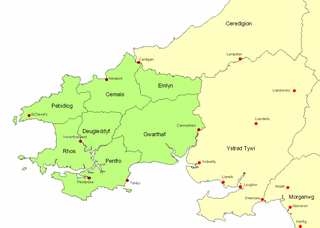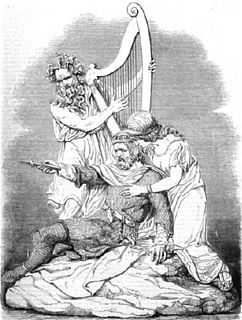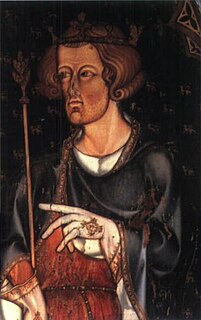Related Research Articles
Taliesin was an early Brythonic poet of Sub-Roman Britain whose work has possibly survived in a Middle Welsh manuscript, the Book of Taliesin. Taliesin was a renowned bard who is believed to have sung at the courts of at least three Brythonic kings.

The Kingdom of Gwynedd was a Roman Empire successor state that emerged in sub-Roman Britain in the 5th century during the Anglo-Saxon settlement of Britain.

Vortiporius or Vortipor was a king of Dyfed in the early to mid-6th century. He ruled over an area approximately corresponding to modern Pembrokeshire, Wales. Records from this era are scant, and virtually nothing is known of him or his kingdom. The only contemporary information about Vortiporius comes from the Welsh ecclesiastic Gildas, in a highly allegorical condemnation from his De Excidio et Conquestu Britanniae. At the time the work was written, Gildas says that Vortiporius was king of Dyfed, that he was grey with age, that his wife had died, and that he had at least one daughter.

Rhodri Molwynog, also known as Rhodri ap Idwal was an 8th-century king of Gwynedd. He was listed as a King of the Britons by the Annals of Wales.

Caradog ap Meirion was an 8th-century king of Gwynedd in northwest Wales.

The Principality of Wales existed between 1216 and 1536, encompassing two-thirds of modern Wales during its height between 1267 and 1277. For most of its history it was ’annexed and united’ to the English Crown except for its earliest few decades. However, for a few generations, specifically the period from its foundation in 1216 to the completion of the conquest of Wales by Edward I in 1284, it was de facto independent under a Welsh prince of Wales, albeit one who swore fealty to the king of England.
Merfyn Frych, also known as Merfyn ap Gwriad and Merfyn Camwri, was King of Gwynedd from around 825 to 844, the first of its kings known not to have descended from the male line of Cunedda.

Yr Hen Ogledd, in English the Old North, is the region of Northern England and the southern Scottish Lowlands inhabited by the Celtic Britons of sub-Roman Britain in the Early Middle Ages. Its denizens spoke a variety of the Brittonic language known as Cumbric. The Hen Ogledd was distinct from the parts of northern Britain inhabited by the Picts, Anglo-Saxons, and Scoti as well as from Wales, although the people of the Hen Ogledd were the same Brittonic stock as the Picts, Welsh and Cornish, and the region loomed large in Welsh literature and tradition for centuries after its kingdoms had disappeared.

Tewdrig ap Teithfallt, known simply as Tewdrig, was a king of the post-Roman Kingdom of Glywysing. He abdicated in favour of his son Meurig (Maurice) and retired to live a hermitical life, but was recalled to lead his son's army against an intruding Saxon force. He won the battle, but was mortally wounded.
Perfeddwlad or Y Berfeddwlad was an historic name for the territories in Wales lying between the River Conwy and the River Dee. comprising the cantrefi of Rhos, Rhufoniog, Dyffryn Clwyd and Tegeingl
The Kingdom of Ceredigion was one of several Welsh kingdoms that emerged in 5th-century post-Roman Britain. Cardigan Bay to the west and the surrounding hilly geography made it difficult for foreign invaders to conquer. Its area corresponded roughly to that of the county of Ceredigion. Ceredigion transparently means "the people of Ceredig."

Gwrtheyrnion or Gwerthrynion was a commote in medieval Wales, located in Mid Wales on the north side of the River Wye; its historical centre was Rhayader. It is said to have taken its name from the legendary king Vortigern. For most of the medieval era, it was associated with the cantref of Buellt and then Elfael, small regional kingdoms whose rulers operated independently of other powers. In the Norman era, like the rest of the region between Wye and Severn it came to be dominated by Marcher Lordships.

Rhwng Gwy a Hafren was a region of medieval Wales, located in the Welsh Marches between Powys to the north and Brycheiniog to the south. It was bounded by the rivers Wye and Severn. It covered about the same territory as Radnorshire, now part of the county of Powys. The region first came into its own in the 9th or 10th centuries, when it was ruled by leaders who operated independently of the surrounding kingdoms. After the Norman invasion, it comprised the central part of the Welsh Marches and was the site of frequent struggles between Welsh and Norman forces.

Manaw Gododdin was the narrow coastal region on the south side of the Firth of Forth, part of the Brythonic-speaking Kingdom of Gododdin in the post-Roman Era. It is notable as the homeland of Cunedda prior to his conquest of North Wales, and as the homeland of the heroic warriors in the literary epic Y Gododdin. Pressed by the Picts expanding southward and the Northumbrians expanding northward, it was permanently destroyed in the 7th century and its territory absorbed into the then-ascendant Kingdom of Northumbria.

The history of Gwynedd in the High Middle Ages is a period in the History of Wales spanning the 11th through the 13th centuries. Gwynedd, located in the north of Wales, eventually became the most dominant of Welsh principalities during this period. Distinctive achievements in Gwynedd include further development of Medieval Welsh literature, particularly poets known as the Beirdd y Tywysogion associated with the court of Gwynedd; the reformation of bardic schools; and the continued development of Cyfraith Hywel. All three of these further contributed to the development of a Welsh national identity in the face of Anglo-Norman encroachment of Wales.
Culture and Society in Gwynedd during the High Middle Ages refers to a period in the History of Wales spanning the 11th, 12th, and 13th centuries. The High Middle Ages were preceded by the Early Middle Ages and followed by the Late Middle Ages. Gwynedd is located in the north of Wales.

Arwystli was a cantref in mid Wales in the Middle Ages, located in the headland of the River Severn. It was chiefly associated with the Kingdom of Powys, but was heavily disputed between Powys, Gwynedd, and the Norman Marcher Lords for hundreds of years, and was the scene of many skirmishes between those groups. Like many other cantrefs and subdivisions, it was divided up by the Laws in Wales Acts in the 16th century.

Buellt or Builth was a cantref in medieval Wales, located west of the River Wye. Unlike most cantrefs, it was not part of any of the major Welsh kingdoms for most of its history, but was instead ruled by an autonomous local dynasty. During the Norman era it was associated with Rhwng Gwy a Hafren, a region independent of the Welsh monarchies and controlled by Norman Marcher Lords. In the 16th century, it was reorganized as a hundred and joined with the former kingdom of Brycheiniog to form the county of Brecknockshire.
Owain ab Edwin of Tegeingl or Owain Fradwr was lord of the cantref of Tegeingl in north-east Wales at the end of the 11th century. He was the son of Edwin of Tegeingl. He sided with the Normans in their failed invasion of North Wales, and in the 1090s attempted to become ruler of Gwynedd.

The conquest of Wales by Edward I, sometimes referred to as the Edwardian Conquest of Wales, to distinguish it from the earlier Norman conquest of Wales, took place between 1277 and 1283. It resulted in the defeat and annexation of the Principality of Wales, and the other last remaining independent Welsh principalities, by Edward I, King of England.
References
- ↑ Historia Brittonum, ch. 70; Nennius: British History, and The Welsh Annals, ed. John Morris (Phillimore, 1980), cap. 70 (p. 81).
- ↑ Lloyd, John Edward (1912). A History of Wales from the Earliest Times to the Edwardian Conquest. Longmans, Green, and Co. p. 281 . Retrieved May 11, 2010.
- ↑ Domesday Book: Herefordshire ed. Thorn and Thorn (Phillimore 1983), A10 (f.179b) and notes on it.
- ↑ Darby, H. C. (1986). Domesday England. Cambridge University Press. p. 328. ISBN 0-521-31026-1 . Retrieved November 17, 2009.
- 1 2 Red Book of Exchequer, ed. Hubert Hall (3 vols. HMSO, 1896: Rerum Britannicarum medii aevi scriptores, 99) II, 762.
- ↑ Paul Remfry, "Discovering the lost kingdom of Radnor", British Archaeology, no 34, May 1998
- ↑ Standard works on Welsh history and early/medieval Wales which do not mention Cynllibiwg at all include the following: John Davies, History of Wales (Penguin, 1992); Sir J. E. Lloyd, A history of Wales from the earliest times to the Edwardian Conquest (revised ed., 1937), the classic survey of the period; R. R. Davies, Conquest, Coexistence and Change: Wales 1063-1415 (Oxford University Press, 1991), probably the most comprehensive and authoritative single volume survey of the period; Wendy Davies, Wales in the Early Middle Ages (University of Leicester Press, 1982), (refers once to Cynllibiwg as a named early region, based on Nennius); J. Beverley Smith, Llywelyn ap Gruffudd, Tywysog Cymru (University of Wales Press, 1986), the most detailed history of the reign of Llywelyn ap Gruffudd, a period which saw him leading several campaigns in the area claimed as a kingdom of Cynllibiwg. The word is not mentioned in contemporary or near-contemporary sources such as the Brut y Tywysogion or the works of Gerald of Wales.